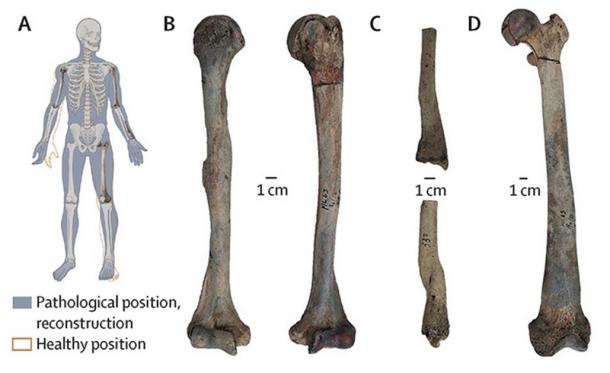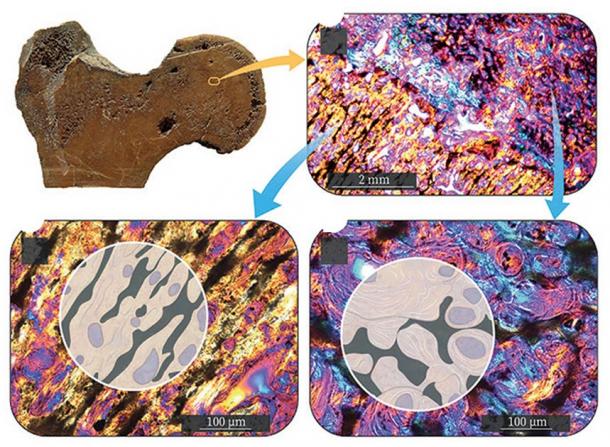Research on a 6,000-year-old skeleton has revealed the undeniable presence of the rare genetic disorder known as stone bone disease or osteopetrosis. This discovery will help us to understand the nature of the disease more fully and is yet another example of how ancient remains can help specialists to understand the history and development of particular diseases and genetic disorders over time.
Julia Gresky, a paleontologist from the German Archaeological Institute, was examining the remains of a man who died 6,000 years ago when she made the discovery alongside her colleagues. The bones were found in the town of Maliq in 1963, in southern Albania. They were found in a Neolithic settlement that was once especially important in the region. The remains came from a male who died in his twenties and was only 5 feet tall (1.5 m).
An examination of the bones using X-rays, CT scans and under the microscope revealed that the man had clear signs of having the genetic disorder commonly called stone bone disease and known to medical professionals as osteopetrosis. The Mail Online reports that these signs include “the bones all being unusually heavy and featuring evidence of tissue stiffening, obliteration of the marrow cavity and distinct flaring of the ‘neck sections’ of the long bones.”

Paleontologists analyzing the remains of a Neolithic man unearthed in Maliq, Albania, have discovered that he suffered from a condition known as osteopetrosis, also known as stone bone disease. (Gresky et al. / The Lancet Diabetes and Endocrinology )
Understanding Osteopetrosis and its Symptoms
In the The Lancet Diabetes & Endocrinology , a journal which publishes ongoing clinical research, the researchers explain that there are “three primary types” of osteopetrosis, namely “autosomal recessive osteopetrosis, intermediate autosomal recessive osteopetrosis, and autosomal dominant osteopetrosis.” The various types are a result of differences in the pattern of inheritance. The Maliq skeleton, which has been carbon-dated to about 4,600 to 4,450 BC, shows that while alive the deceased suffered from the autosomal dominant osteopetrosis version of the disorder.
Newsopener reports that “autosomal dominant osteopetrosis, which is also called Albers-Schönberg disease, is typically the mildest type of the disorder.” Some of those with this disorder have no symptoms. However, in their adolescence and twenties, some begin to suffer from multiple bone fractures, the curvature of the spine and other conditions such as arthritis and bone infections. “Autosomal dominant osteopetrosis has a general worldwide prevalence of one in 20,000 births and is therefore classified as a rare disease,” explains the Newsopener. More severe forms of stone bone disease can lead to low immune systems, intellectual disabilities, recurring infections and most who suffer from the most severe form die in the first decade of their lives.

While it is impossible to prove how much this genetic condition would have affected the life of the Neolithic person whose remains were found at Maliq, their analysis does show that he suffered from osteopetrosis, also known as stone bone disease. (Gresky et al. / The Lancet Diabetes and Endocrinology )
Only Palaeopathological Evidence of Osteopetrosis on Record
The researchers wrote in the Lancet that “the case presented here is so far the only case of autosomal dominant osteopetrosis on record supported by direct palaeopathological evidence.” Of the three previously identified cases of osteopetrosis, two have been shown not to have the condition while a third dates from the 4 th century AD. This means that the Maliq skeleton is the oldest known case of the condition by thousands of years.
The researchers found that Maliq man’s condition was the same as cases of autosomal dominant osteopetrosis seen today. This is an important discovery and according to the Mail Online this means that the “stability in the disease suggests it is also unlikely to change in the future.” Because the disease is rare it can be difficult to study and there is a lack of research on the genetic disorder.
The study of ancient cases can provide much-needed information as they can undergo more intensive investigations that would be hazardous to live patients. In the Mail Online the team is quoted as saying that “adding ancient cases, while respecting the ethical limits for exploring human remains, can provide different data to those that can be taken from a living patient.” This could help experts to better understand conditions and could potentially lead to improved treatments.
It is not known how osteopetrosis affected the man during his life. However, one of the Maliq skeleton’s humeri showed signs of fracture or malformation. Dr. Gresky told the Mail Online that “he might have been slightly restricted in severe physical work, but this cannot be entirely proven.” If he was restricted in his activities he may have needed the support of his community and family, which is offering an important insight into a Neolithic society. The team are continuing to study ancient remains to understand if stone bone disease was more prevalent in the ancient past than today.
Top image: Research on a 6000-year-old skeleton has revealed the undeniable presence of the rare genetic disorder known as stone bone disease or osteopetrosis. Left: Left femur in an X-ray. Right: CT scan slices of the same femur (center) are compared with those of a healthy individual (far right). Sourse: Gresky et al. / The Lancet Diabetes and Endocrinology
By Ed Whelan
Related posts:
Views: 0
 RSS Feed
RSS Feed

















 October 27th, 2020
October 27th, 2020  Awake Goy
Awake Goy  Posted in
Posted in  Tags:
Tags: 
















